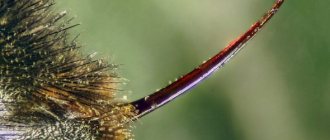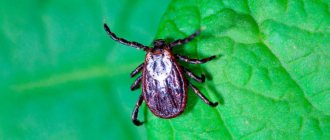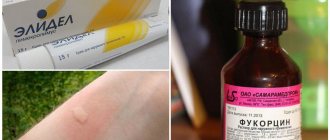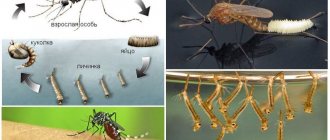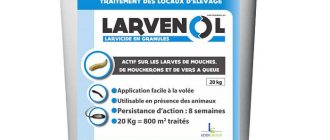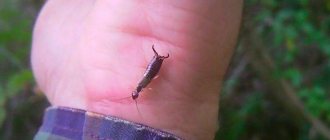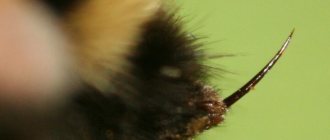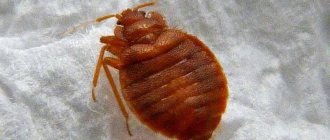Wasp sting - how to remove it
When people relax outdoors or live in rural areas, they can be attacked by wasps.
This situation is always unpleasant, because flying insects sting quite painfully. At this moment, many are lost and do not know how to behave. This article will examine in detail what a wasp sting is and what consequences can arise from an insect attack.
If a sting remains after a wasp sting, what to do first and what assistance to provide. Detailed instructions on how to remove a wasp sting if it is not visible.
What are the human reactions to wasp venom?
In order not to get confused after an unexpected wasp sting, you need to know what possible reactions of the human body to poison.
Of course, each organism is unique, but the following options can be distinguished:
- the first reaction is redness at the site of the bite, rapid swelling and severe itching;
- hemorrhage from the bite site is possible if small blood vessels were damaged by the insect;
- an allergic reaction, since wasp venom is the strongest allergen.
Wasp sting: methods of extraction from the human body
Wasps are not large insects, so their sting is only a couple of millimeters long. Only the female has a sting; males do not have it. After a person is stung by a wasp, many immediately try to squeeze out or pull the sting out of the body. However, they don’t find him and begin to panic.
Wasp sting - how to remove it
It should be noted here that, according to statistics, bees bite people more often and people are somewhat accustomed to their behavior. For example, few people know that if a wasp stings, it rarely leaves a sting in a person’s skin. That is why searches do not lead to results.
Important! Many people are immediately lost and don’t know what to do if they were bitten by a wasp and left a sting. Don't panic - the first thing you need to do is examine the affected area of the skin, disinfect it and try to detect the sting.
Where is the wasp's sting located?
People often confuse wasps with bees and are not sure whether a wasp has a sting. As mentioned earlier, only the female has a sting. It may look like a tiny needle if the individual is young or like a transparent gray rod if the insect is already an adult. The exact location of the sting is the niche where the female produces eggs. The ovipositor is located in the lower part of the abdomen, and the sting is used to obtain food for itself to feed the entire wasp nest.
Males do not have stingers because their anatomical structure is different and they cannot produce eggs. Previously, the wasp's sting was not poisonous, but during evolution, the insect's body began to produce a poisonous enzyme for defense and hunting. They use venom to protect themselves from other predators or sting someone to kill and eat. Wasps never hunt people purposefully, so if they stung someone, it wasn’t intentional.
First aid
It will be difficult to get the sting yourself
Getting the sting out on your own without special objects will be problematic, and examining it without a magnifying device will be doubly difficult. If the bite is on the leg or the finger is injured, the sting can be removed using tweezers. It is much more difficult if the wound is on the back of the body, which is difficult to examine on your own. In this case, you cannot do without outside help.
After a bite, the skin swells within minutes and redness appears around the area where the sting is supposed to be located.
Attention! The poison cannot be squeezed out. When you press on the skin around the bite, there is a danger that the poisonous enzyme will spread throughout the skin and enter the blood.
It is necessary to prevent this process, immediately treat the bite site with hydrogen peroxide and apply a cold compress. A person may immediately have an allergic reaction, so you need to take one of the medications that fight allergies:
A cold compress will gradually relieve pain and swelling will begin to subside. In order to remove the sting, you need to find a room with good lighting and, using a magnifying glass or other magnifying device, examine the sting site. It will be possible to remove the sting if a point is noticed on the skin. It will be transparent gray. You should act carefully and grab the head of the sting with tweezers. Squeezing with forceps should occur simultaneously with a sharp movement to the side - this jerk will allow you to pull it out.
On a note! Under no circumstances should you relieve stress with alcohol. Alcoholic drinks will only provoke the spread of poison throughout the human body.
What does a wasp sting look like on a human body after a bite?
The structure of the sting is long, very strong with a pointed end. It is hollow inside, which allows the poison to move through the sting channel. The poison is produced by a gland that connects to the sting in the wasp's abdomen. The sting leaves the wasp's body with the help of a sharp contraction of muscles during an attack.
A wasp can sting in the middle of summer if a person is relaxing in nature or lives near a wooded area. Wasps live where there are bodies of water and a lot of vegetation. The wasp will not purposefully track down a person and sting him. This can happen during flight when a person accidentally touches an insect with his body.
On a note! A wasp differs from a bee in that it can sting several times, and the bee dies after the first such attack.
Is it necessary to remove a wasp sting from the bite site?
If the victim is sure that the sting remains after a wasp bite, it is better to remove it immediately. After examining the bite site, if there are no obvious signs of a sting, you should use magnifying devices or immediately consult a doctor. Even if you decide to go to the medical center, it is necessary to disinfect the affected area of the skin.
If the sting is noticeable on the skin, then removing it at home will not be difficult and it is better to do it right away. In order not to tear it into two parts, you cannot rush. If the piece remains inside, a serious inflammatory process will begin.
Is it necessary to remove a wasp sting from the bite site?
The danger from a wasp sting can be different. It all depends on the concentration of the poison that got under the skin. In addition, there are many varieties of wasps, and if a person is bitten by a hornet, the largest individual of this species, then the amount of toxic composition that can enter the bloodstream will become fatal.
This is interesting! In Japan, where there are many of these insects, deaths from a hornet bite are not uncommon. European varieties are less dangerous, they are not as aggressive.
Methods for removing stings from the human body
If an encounter with an insect has already occurred, people are immediately lost and do not know what to do if a sting remains after a wasp sting. No need to panic. Most often, the sting remains in the human body along with the insect’s abdomen. If the top part is visible, you can try to pull it out with your fingers. You cannot press a foreign object into the body; you need to make a sharp movement away from yourself.
Detailed anatomy: wasp sting under a microscope
A wasp sting is a long, strong, pointed organ connected to a poisonous gland and having a duct inside through which the poison from the gland is introduced into the body of the victim.
The photo below shows the sting of a common wasp (Vespula vulgaris):
And here you can see what the sting of a hornet (Vespa crabro) looks like:
The sting is located in the back of the abdomen. In most wasps, in a calm state, it is retracted inward, and when bitten, it is removed due to contractions of special muscles.
Examining a wasp sting under a microscope, you can see that it has smooth walls and is translucent, but when viewed with the naked eye, this organ appears dark brown:
It is interesting that it is precisely in its smoothness that the sting of a wasp differs significantly from the sting of a bee: the latter has numerous notches on this organ. It is because of the presence of such notches that the bee sting is firmly held on the victim’s skin, like a harpoon. Unable to reach it, the bee flies away with its internal organs partially torn out and subsequently quickly dies:
The photo below shows what a bee sting looks like under a microscope:
Structurally, the wasp's sting consists of two elongated stilettos - it is they that pierce the integument of the victim's body. They move out of the insect's abdomen along special structures called sleds. These sleds, in turn, are closed by several plates at the posterior end of the wasp’s body. When a wasp stings, the plates move apart, the sled moves slightly out of the abdomen, and the stilettos slide along them.
The video clearly shows how the wasp extends its stinger from its abdomen:
When stung, venom flows out of the canal between the stylets and the sled. There is no such channel in the stylets themselves, and if the wasp does not manage to insert the sting to a sufficient depth, the poison does not enter the victim’s body.
The photo shows what a wasp sting looks like at the moment of partial extension from the abdomen:
This is interesting
The wasp sting is a modified ovipositor that has evolved into a formidable weapon. A similar ovipositor is found, for example, in grasshoppers and locusts (popularly it is also called a sword because of its characteristic shape), as well as in some other insects. But if in the same locust the ovipositor performs its direct functions and serves to remove eggs from the female’s body, then in wasps it was supplemented with a poisonous gland during evolution, became harder and stronger, and insects use it specifically for hunting and protection.
Riders - close relatives of wasps - are a kind of transitional group in this regard. Their ovipositor is not retracted into the body and can be very long. With its help, the insect pierces the integument of the victim and introduces its eggs into its tissue. Some riders can sting a person painfully: thus, their ovipositor also performs both functions - protection and reproduction.
But male wasps do not have a sting. Considering that the predecessor of this organ - the ovipositor - is the prerogative of only females, it becomes clear why males lack a sting.
It is also useful to read: What to do if a child is suddenly bitten by a wasp
However, in nature, it is very difficult to outwardly distinguish male paper wasps from females, and it is usually not possible to guess which insect can sting and which cannot. In addition, among ordinary social wasps, males are extremely few in number, appear only in late summer or early autumn and live only two to three weeks. So most of the wasps encountered are females that have a sting.
On a note
Each wasp has only one sting. Theoretically, the loss of just this organ is not fatal to the insect. However, in real conditions it does not lose it, since the smooth walls of the sting make it easy to remove it from the victim’s body and use it many times.
Precautionary measures
The most dangerous period of time, when there are many female wasps, is the end of summer and the beginning of autumn. It is during this period that they collect pollen from flowers and store food for the winter. Large concentrations of these insects can be found in the forest. Aspen nests are located on large trees. A person will be warned of danger by a not loud, but noticeable buzzing.
Attention! You should not approach the nest, much less disturb it with a stick for fun. In this case, the wasps will protect their home and a person will not get away with just one bite.
With several bites of these insects, a lethal dose of poison can be obtained even from small individuals. In this case, the person may not even be taken to the hospital, and it will no longer be so important whether the wasps left a sting or not.
Experts name several preventative measures:
- Clothes should be dark shades.
- The smell of perfumes and cosmetics repels these insects.
- You should not walk near aspen nests and it is better to avoid walking on the grass without shoes.
- It should be remembered that bees and other honey plants are attracted to sweets (spilled jam, open sweets, etc.)
If the operation at home was successful, then you should immediately treat the wounded area with hydrogen peroxide and go to the medical center. Removing the sting does not mean that the danger has passed. Most likely, the poison has already entered the bloodstream. Doctors will give directions for tests and prescribe the necessary medications.
In any case, a person should always be vigilant and closely monitor the activity of insects around. And then trouble can be avoided.
Wasp stings or bites
Many people know that the wasp has a sting, but not many know that only female representatives are armed with it. With the help of its sting, the wasp protects itself from enemies and also attacks its prey. The sting is a modified ovipositor, so males do not have such a formidable weapon. As a rule, the wasp family is mainly represented by females, so it is generally accepted that all wasps have a sting.
Which is correct: does the wasp bite or sting?
The wasp is armed not only with a sharp sting, but also with fairly sharp jaws, with which it can easily bite through the chitinous layer of some insects. Therefore, it does not always use its sting when hunting insects. At the same time, she saves poison. When a wasp bites a person, it certainly uses its sting , injecting a certain dose of poison into the wound. At the same time, having bitten once, she tends to do it again, since the sting does not remain in the victim’s body. Therefore, a wasp can bite several times, and the number of bites depends on the type of wasp, its age and the amount of poison that the wasp’s body can produce. As a rule, each wasp is capable of stinging at least 5 times, which can lead to a number of negative consequences. Below you can see a wasp's stinger piercing a person's body.
Interesting to know! Wasps are quite aggressive insects, but the main aggression is possible if the wasp senses danger or someone is trying to destroy its nest. If someone tries to get rid of a wasp nest without protective equipment, they will receive a lot of bites from the entire family. In case of danger, they give signals, after which a whole swarm can appear next to the enemy.
Does a wasp leave its stinger after stinging?
The structure of the sting of wasps, compared to bees, is completely different, smooth, without notches, so after a bite the wasp easily removes it from the victim’s body. In this case, the wasp does not die like a bee and can bite several more times. It is possible that the wasp can leave its sting only if it can be killed during the bite.
If a wasp sting does end up in a person’s body, then getting rid of it is quite simple. For this it is possible:
- Use tweezers or a needle, as well as regular fingers, but before doing this, your hands and tools must be disinfected.
- In no case should you rush, compared to a bee sting, which must be pulled out as soon as possible.
- The sting must be pulled out carefully and carefully so that it does not break and part of it does not remain in the human body.
Different wasps, different stings, different bites
Wasps, hornets, bees, gadflies - they all bite differently and the consequences of the bites are not the same.
Gadflies are the nastiest - they bite off a piece of skin and try to lay eggs inside - favorable conditions for the young.
Hornets and bees bite equally painfully and are equally scary for allergy sufferers. For non-allergy sufferers, a hornet sting is useless, it hurts a lot and only causes inconvenience, but a bee sting improves your health.
Bee venom normalizes blood pressure, strengthens the immune system and blood vessels, dissolves cholesterol, improves memory and metabolism. The only disadvantage of bee stings is that the bitten person will be marked with special pheromones, which automatically makes him an enemy for all bees flying past, so it is better to retreat immediately - numerous bites are life-threatening.
The sting of a common wasp causes swelling and redness, but if you do not scratch it, it goes away in a couple of days. Other wasps are even less dangerous. Scolia produces little venom, the bite site goes numb for a couple of hours, then everything goes away without a trace. Philantines only bite through delicate skin, so you can safely smack them with rough palms.
Other types of wasps prefer not to enter human territory. You can meet them in the wild - on a picnic or on a hike. If you don’t have an antihistamine with you, you can reduce the effect of wasp venom with improvised means - any sour product: lemon, sour berries, sorrel... It will be good to apply cold, drink more and get back to civilization.
The structure of a wasp sting
If you take a magnifying glass, the structure of the sting can be studied in more detail, although the naked eye can see that a sharp needle sticks out of the wasp’s body. Below in the photo you can see what a wasp sting looks like.
The appearance resembles a rather sharp element, inside of which there is a channel that is connected to the gland that produces poison. After a bite, the sting expands and a portion of the poison enters the wound. In its normal state, the sting is practically invisible, since it is retracted into the abdomen and covered with protective plates. In case of aggression, the needle extends and performs its protective functions.
The surface of the wasp's sting is smooth, without serrations, so it easily penetrates the body of its victim and is just as easily removed from it.
Important point! The sting is transparent, although visually it is dark, almost black.
Degree of toxicity of the poison
Regardless of the type of wasp, the structure of the sting has identical characteristics, but the nature of the bite and the consequences depend on the toxicity of the poisonous secretion.
- The hornet is the largest wasp and its sting is quite painful. In addition, the hornet has a fairly toxic poison that can seriously harm human health. The Asian hornet kills a person prone to allergies in a few minutes. Every year, up to 50 people die from hornet stings in countries such as Japan and China. The nature of the bite is comparable to the penetration of a hot nail into a person’s skin. There are no such dangerous insects in our territories, but a person can die after 5 bites of such insects if help is not provided in a timely manner.
- Scolia giants are also among the largest wasps on the planet. It should be noted that their sting is small, and the poison is not toxic to humans. In the case of a scolius bite, short-term numbness of the bite site is possible, for several minutes. Only allergy sufferers or children who still have a weak immune system can suffer from a bite of this species. These insects are not aggressive, so they prefer not to participate in various conflict situations, including with humans. In addition, scolias are not considered social insects and do not live in large families, so numerous insect bites are not a threat.
- Philants are among the most harmless creatures representing the wasp family. They live deep in the earth, in burrows they have dug. These insects also have a second name - bee wolves, since adult individuals are capable of destroying bee colonies, since bees form the basis of their diet. The larva eats 5 bees to become an adult. As a rule, bee wolves attack their prey in flight, inserting a stinger into it, which leads to paralysis of the insect. After this, they eat their prey or take it to their nest. Philants live in the ground, and they can easily find their nest at any distance.
- Pompylids are wasps with a long sting and a potent venom. Therefore, the bites of these wasps are quite painful. These insects are quite aggressive and attack at the slightest sign of aggression towards them. More than 150 species live on our territory. Adult individuals grow up to 3 cm in length and lead an isolated lifestyle, without creating nests or numerous families. Eggs are laid on spiders. After hatching, the larva eats the spider from the inside. The sting of these aggressive insects is quite powerful and strong.
It is very important to know what to do if a wasp does bite you. This is especially true in relation to those people in whom the body reacts very violently to the action of insect poison, causing severe consequences, and sometimes even fatal.
A few words about relatives of wasps and their stings
All types of wasps have a sting, and in each case it is a formidable weapon. Only the concentration of the poison will be different, and, consequently, the strength of its effect on the body of the bitten person. By the way, here, for the same reason, the pain sensations will be different.
- Pompilid bees, the road bees, are known to give almost the most painful sting. Among insects, only South American bullet ants are ahead of them in this regard. These wasps live in the ground. They dig their holes and lay clutches directly on spiders paralyzed by the sting, which subsequently become food for the hatched larvae. By the way, about 200 species of road wasps are found in our country. And this fact still cannot but alarm.
- The largest wasp is the hornet and its bite is also quite painful. It is believed that a portion of poison injected with one sting can cause serious health problems in humans and even lead to death. The largest number of hornets is observed in Japan and, according to statistics, deaths in this country from hornet stings are not uncommon. These insects are also found in Europe, although not as aggressive as the Asian ones.
- And, for example, scolias, although they are the largest hymenopteran insects, they do not sting very painfully. At the same time, the toxicity of their venom is also low - the worst thing that can provoke their bite is numbness in the affected area. And this happens because of the insignificant concentration of the poisonous secretion, which makes the bites of these wasps relatively safe for human health.
- Philants, or hunter wasps, or bee wolves, are not at all capable of biting through the skin of a person’s palm. They cause the main damage to beekeeping farms and sometimes even sting beekeepers. But their bites are practically painless, and therefore people are not afraid to catch them simply with their bare hands.
Speaking about the aggressiveness of wasps, it is worth noting that they never attack a person for nothing. They attack people solely to protect themselves or their nest. And even in such situations, they act consistently, so to speak, trying to avoid conflict: first, the disturbed insects try to leave the danger zone and only, finding themselves in a critical situation, begin to inflict poisonous injections with their stings. But if a person is too close to the nest, then the wasps can attack immediately. Therefore, if, while at the dacha or simply relaxing in nature, you notice a wasp nest nearby, try not to make sudden movements and leave this place as carefully as possible, moving away from it. If an insect lands on your body, then under no circumstances slam it with your palm, just brush it off the skin. Often this is quite enough to prevent the wasp from stinging you.
Does the wasp bite or sting?
The wasp is known to have a sting. But it turns out that not every individual has it, but only females. With its help they defend themselves or attack. A wasp hive is mainly filled with females, so it is believed that all individuals have a sting.
These insects are also armed with sharp, strong jaws that can easily bite through chitin. A wasp bites when attacked by insects. But when faced with a person, she uses a sting to release her poison from him. She does not stop at one bite, but tries to hit the person several more times in order to inject as much poison as possible. Depending on the age, type and volume of poison, the wasp stings at least 5 times.
Does the wasp die?
The bee stings and dies, because during the detachment of the sting, the gland with poison and the digestive tract are damaged, which leads to death.
The wasp stings a person and, with the help of its muscles, pulls him back and flies away, even if it so happens that she loses her weapon, this will not affect her life in any way, the only thing is that she can only defend herself with the help of her jaws.
Wasps have an amazing feature, due to the fact that they have thin waists, they are able to fold in half and deliver devastating blows. A huge number of species, from large to small representatives, have their own poison and can harm human health from a few seconds to one minute.
Please note that hot weather fuels their aggressive reaction. This is such a dangerous and insidious species of insects, but let’s make a reservation that they will never attack without a reason.
The structure of a wasp sting
Female wasps use their sting for defense and attack. Its role is to paralyze the victim. If it is an insect, it is taken to the wasp hive for food.
The sting consists of:
- poison gland;
- pointed proboscis;
- internal duct.
It is through the internal duct that the poison from the gland enters the victim. The shape resembles a regular needle. Although it is thin, it is quite strong, as it consists of chitin. The formation of the weapon begins in the egg, so males, in principle, do not have the opportunity to possess it. The length of the sting is impressive, since the wasp extends it when biting. The proboscis and duct can be examined using a microscope.
Bites of different types of insects
Almost all representatives of this species are endowed with a sting. The difference lies in how allergenic the poison is and how it affects the human body:
Asian giant hornet sting
The sting of Asian hornets, which are a prominent representative of the wasp family, can be fatal for allergy sufferers. And a person stung by several individuals at the same time, even if he is not susceptible to allergic diseases, can die if assistance is not provided in a timely manner. In countries where these insects live, several dozen deaths from hornet attacks are recorded annually.
A hornet sting can be very dangerous even for those who are not allergic to stings
Copy family
They are not inferior in size to hornets and, unlike the latter, sting weakly. Their poison is not so toxic; it is intended to affect sedentary prey and only paralyzes it. Therefore, the effect of poison on humans is limited to slight numbness of the tissue at the site of the bite.
Scolia's bite is not dangerous to humans, causing slight numbness
Road wasps
In contrast, road wasps, whose main prey are poisonous spiders such as tarantulas, bite very painfully. Compared to the reaction to the sting of all other relatives, they bite the most painfully.
A wasp can sting about 4-5 times in a row.
Philantes or bee wolves
This is another type of wasp. But since they hunt exclusively honey bees, nature has endowed them with a too thin sting. It is not capable of piercing rough human skin, so beekeepers often catch them without using protective clothing.
Bee wolf or "philant" for humans, this type of wasp is not very scary.
Video: Measures and actions in case of a wasp or hornet bite
How dangerous is the poison?
The insect is dangerous because its poison can cause a severe allergic reaction, even leading to death. Many people are unaware of their high sensitivity to this poison until the moment they are bitten. Although wasps sting quite often. The bite is accompanied by sharp pain, the wound swells, and a burning sensation is felt. This is the least you can get away with in such a situation. The consequences may be unforeseen.
The poison contains substances such as:
The whole difficulty lies in the fact that without encountering a wasp, it is impossible to know about the presence of sensitivity to these substances. Therefore, an attack by a stinging insect can lead to unpleasant consequences and even death, although this is a very rare occurrence.
The properties of substances also include:
- destruction of body cells;
- causing tumor;
- triggering allergies;
- impact on the nervous system.
It is because of the action of the poison that the bite site becomes inflamed and does not heal for a sufficiently long period of time. Itching may also add to the pain. If the pain does not go away after 2 weeks, it is best to consult a doctor.
Most bites occur on the arms and legs. But cases of stinging in the head also occur. If the sting gets into the face, it may change beyond recognition. The eyelids swell to such a size that the eyes cannot see anything. Bites on the tongue often occur. This happens when a wasp sits on food, but a person did not notice it and took it into his mouth. The swollen tongue becomes so large that the mouth may not close.
What to do if bitten by a wasp?
Let us consider in detail what to do if it was not possible to avoid a wasp attack. The child must inform adults about this. Below are the measures that should be taken first, as well as how to protect yourself and your loved ones.
How to remove the sting?
Bees bite much more often than wasps. Therefore, a stung person cannot always accurately determine who attacked him. A wasp sting very rarely remains in the human body. This is only possible if it breaks off. The site must be inspected immediately. Since the wound swells quickly, examination will not yield results after a few minutes.
You should immediately treat the wound and apply cold to reduce swelling. If it is impossible to examine and remove the sting on your own, then you should seek help. To remove it you will need a magnifying object, good lighting and tweezers. Having grabbed the head, you should immediately pull the sting out of the wound.
First aid
Proper first aid can significantly reduce the risk of an anaphylactic reaction. What to do in this situation:
- Place the stung person in a cool place. High temperatures can worsen the victim's condition. Do not let your head tilt to the side or back.
- Wash the wound and treat with an antiseptic.
- Apply ice or any cold compress to reduce swelling and pain.
- Apply a remedy to the wound that eliminates local reactions. For example, cream “Rescuer”.
- Give an antihistamine. For children, use age-appropriate medications.
Advice! When going outdoors, it would be good to pack a first aid kit with you to provide first aid in such situations.
- Drink as much water as possible.
- If an anaphylactic reaction occurs, call an ambulance.
Allergic reaction
The action of immunoglobulins in a healthy body can neutralize the effect of poisons. Its production begins immediately after the foreign substance enters the body.
If the person bitten is allergic to wasp venom, the reaction to the bite may be unpredictable. You can distinguish an allergic reaction from a normal one by the location of the bite. The first thing that will confirm the guesses is large swelling, more than 1 cm in diameter. The further occurrence of reactions depends on the human body.
Interesting! Allergy sufferers are issued special passports indicating personal data, allergen tests and first aid measures.
Allergy symptoms also:
In addition to local reactions, the following may appear:
- headache, dizziness;
- nausea;
- decrease in blood pressure;
- difficulties with the breathing apparatus;
- elevated temperature;
- pale skin;
- muscle spasm.
The manifestation of the listed symptoms can begin within 20 minutes after the sting.
Anaphylactic shock that develops within the first 5 minutes is a strong and dangerous reaction of the body. It begins with difficulty breathing and swelling of the larynx. If such a reaction occurs, immediate medical attention must be provided. Prednisolone and adrenaline are administered, and a tourniquet is applied above the wound. Further treatment is carried out in a hospital setting.
Is a wasp sting dangerous?
The danger to the victim is high. The most insignificant thing that can happen is a slight swelling and itching, redness at the site of the bite.
But if the patient is not provided with timely assistance, other more significant consequences may occur:
- Hemorrhage is a natural reaction on the part of the body to an insect bite, in which blood may flow from the wound.
- Allergy – after all, poison is a very strong allergen, causing itching and swelling at the site of the bite, runny nose and profuse lacrimation.
- Attacks of headaches, increased body temperature.
- The patient loses consciousness - this is especially typical for patients sensitive to pain.
Let's celebrate! But in any case, it is worth remembering that the swelling subsides in 3-4 days, and for complete healing of the wound it takes one and a half to two weeks. During this period of time, it is worth treating it with medications prescribed by a doctor and keeping it clean.
How to remove the sting?
How exactly to remove the “weapon” of a striped insect from a wound:
- Remove with a sharp and thin needle - remove the sting as quickly as possible, since along with it the insect leaves a gland with poison in the body. But despite the speed of the operation, you should act carefully so as not to crush the bag of poison.
- They can also remove it with tweezers - they carefully grab the “stinging weapon” and pull it out from the wound.
Let's celebrate! If the sting is embedded as deeply as possible, you should consult a doctor or a medical facility.
First aid
First aid is as follows:
- If the reaction is minor, then at home you can wash the wound with warm water and soap, then treat it with baby oil or cream.
- You can also apply a cold compress to the wound - this will relieve pain and swelling.
- The wound itself must be kept clean - be sure to apply a gauze bandage to prevent further infection.
- If severe itching or irritation of the dermis occurs, you can treat the wound with hydrocortisone cream or calamine lotion.
- Baking soda mixed with water or cream to a paste consistency will relieve redness and irritation of the dermis.
- The pain syndrome can be relieved by taking painkillers - Ibuprofen, and to eliminate itching and allergic symptoms - antihistamines such as Diphenhydramine.
But if the body’s reaction shows itself to be rapidly developing negative symptoms - swelling, allergies, suffocation, you should immediately call a doctor.
A wasp and its bite can be very dangerous for humans, but timely measures taken will help prevent the development of negative symptoms.
Let's celebrate! But if you take precautions in your behavior in nature, do not use strong-smelling aromas, perfumes and do not make sudden movements - all this will help you avoid a collision with this striped insect.
